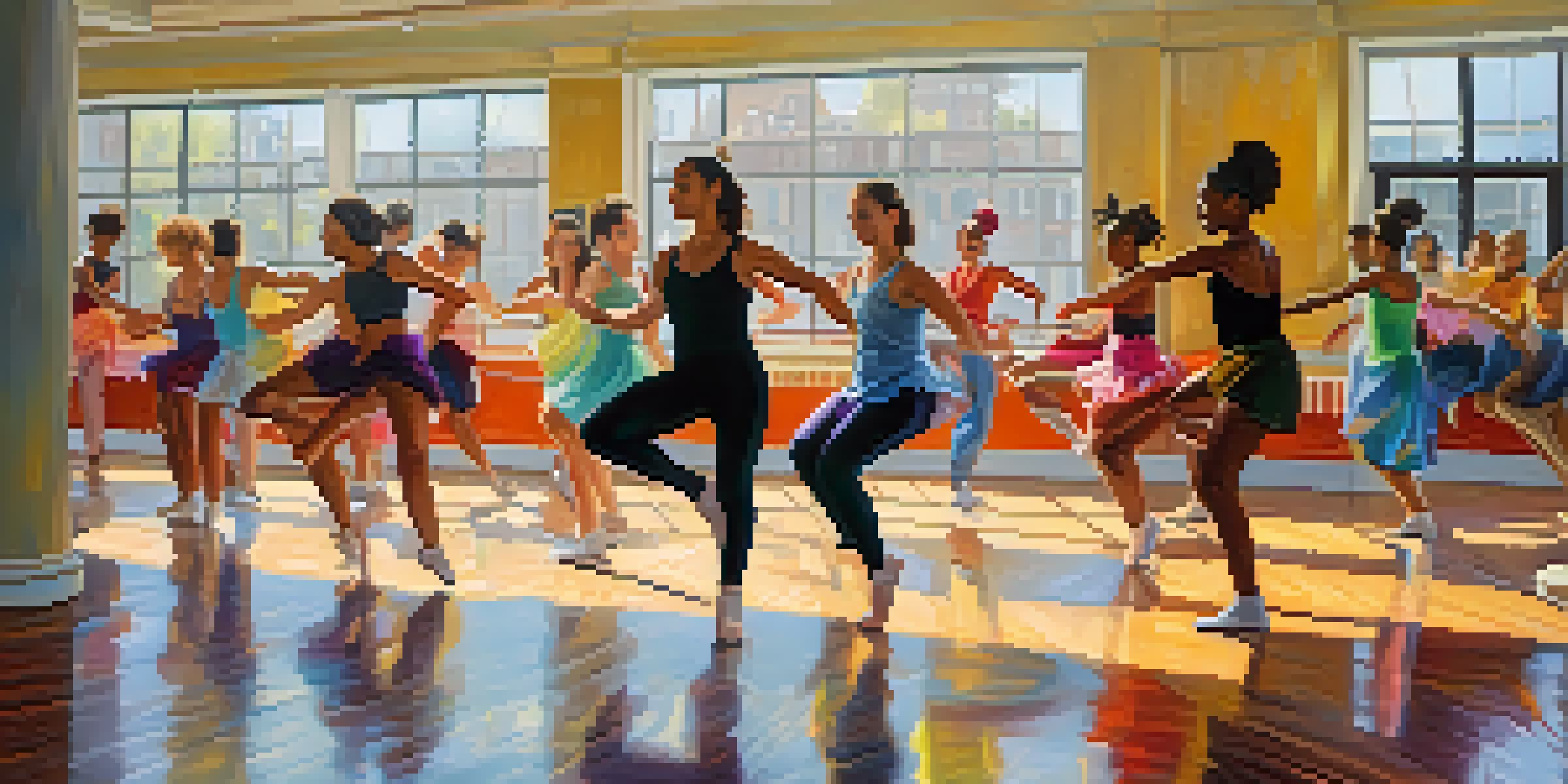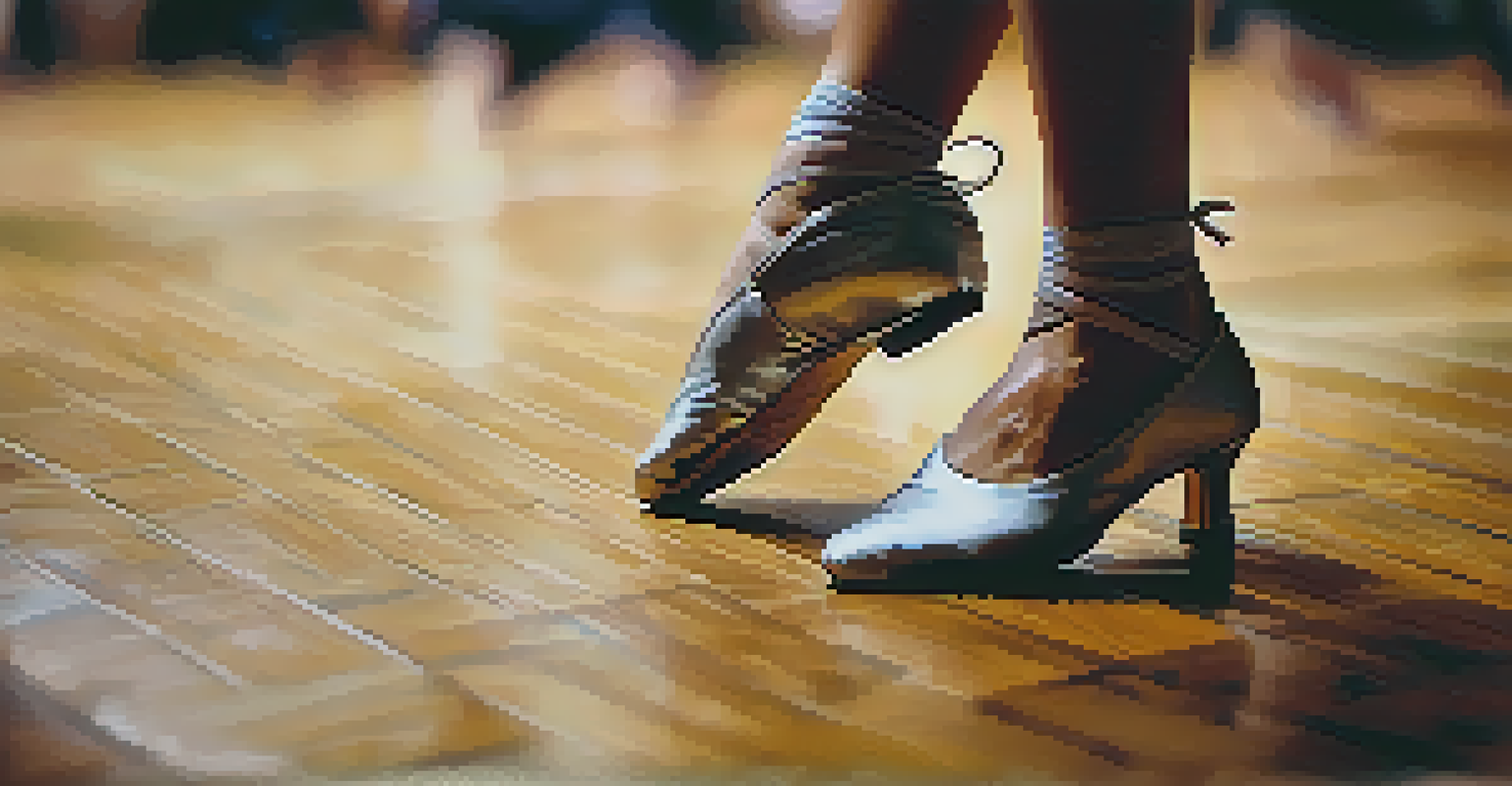Dance Training and Its Influence on Brain Development

The Connection Between Dance and Brain Health
Dance is not just a form of expression; it's a complex activity that engages multiple areas of the brain. When we dance, our brains are busy processing rhythm, timing, and spatial awareness, which are all crucial for cognitive development. This multi-faceted engagement helps to strengthen neural connections, leading to improved brain function.
Dance is the hidden language of the soul.
Moreover, studies have shown that regular dance practice can enhance memory and learning capabilities. This is because dance requires both physical movement and mental coordination, making it an excellent workout for the brain. Think of it like a gym session for your mind, where every step you take is building a stronger cognitive foundation.
In essence, the synergy between physical activity and mental engagement found in dance training creates a unique opportunity for brain health. By fostering creativity and quick thinking, dance not only enriches our physical abilities but also sharpens our mental faculties, making it a holistic approach to brain development.
How Dance Enhances Cognitive Skills
Engaging in dance training can lead to significant improvements in cognitive skills such as problem-solving and critical thinking. When dancers learn choreography, they must memorize sequences and anticipate movements, which sharpens their ability to think on their feet. This kind of mental agility is valuable in everyday life, from academic pursuits to professional challenges.

Take, for example, a dancer who rehearses for a performance. This process involves not just physical practice but also analyzing how to convey emotions and tell a story through movement. Such tasks require a high level of cognitive function, enhancing skills like attention to detail and emotional intelligence.
Dance Boosts Brain Function
Engaging in dance enhances cognitive abilities by strengthening neural connections and improving memory through physical movement and mental coordination.
Ultimately, the cognitive benefits of dance extend far beyond the dance floor. By enhancing our ability to process information and respond to dynamic situations, dance training equips us with life skills that are essential in our fast-paced world.
Dance as a Tool for Emotional Expression
Dance serves as a powerful outlet for emotional expression, which can significantly influence brain health. When individuals engage in dance, they often experience a release of endorphins, the body's natural 'feel-good' chemicals. This not only boosts mood but also helps reduce stress and anxiety, fostering a healthier mental state.
The body says what words cannot.
Furthermore, expressing emotions through dance can lead to improved self-awareness and confidence. As dancers learn to convey their feelings through movement, they cultivate a deeper understanding of themselves and their emotions, enhancing their emotional intelligence. This self-awareness is crucial for mental well-being and resilience.
In a broader sense, dance encourages social interaction, which is vital for emotional health. Whether in a dance class or a social dance setting, connecting with others through movement fosters a sense of community and belonging, further supporting our emotional and cognitive development.
Physical Benefits of Dance Training
While the brain benefits of dance are profound, we must not overlook the physical advantages as well. Dance training is a full-body workout that improves strength, flexibility, and coordination. These physical improvements not only enhance performance but also promote overall health, which is closely linked to cognitive function.
Regular physical activity, such as dance, increases blood flow and oxygen to the brain, which is essential for optimal brain health. This boost in circulation can lead to improved concentration and memory, making dance training an effective strategy for both physical and mental fitness.
Emotional Health Through Dance
Dance serves as a powerful outlet for emotional expression, promoting self-awareness and reducing stress, which benefits mental well-being.
By integrating physicality with creativity, dance training offers a unique approach to holistic health. This combination not only keeps the body fit but also nurtures the brain, proving that movement truly can be a catalyst for cognitive growth.
The Role of Music in Dance and Brain Development
Music plays a critical role in dance, serving as both the backdrop and the driving force behind movement. This connection between music and dance activates various brain areas responsible for auditory processing, rhythm recognition, and emotional response. When we dance to music, our brains are engaged in a complex dance of their own, enhancing cognitive function.
Research indicates that combining music with physical activity, like dance, can lead to heightened memory retention and learning. For instance, studies show that students who learn through musical methods often perform better academically. This suggests that the rhythmic and melodic elements of dance can be a powerful tool for cognitive enhancement.
Ultimately, the interplay between music and dance creates a rich sensory experience that stimulates the brain. This dynamic relationship not only makes dance enjoyable but also enhances its cognitive benefits, making it a multifaceted approach to brain development.
Dance Training and Neuroplasticity
Neuroplasticity refers to the brain's ability to reorganize itself by forming new neural connections throughout life. Engaging in dance training can stimulate neuroplasticity, as it requires learning and adapting to new movements and patterns. This constant mental and physical challenge encourages the brain to create and strengthen pathways, enhancing overall cognitive function.
As we age, maintaining neuroplasticity becomes increasingly important for brain health. Dance training provides a fun and engaging way to keep the brain active and adaptable. For older adults, for instance, dance can be a particularly effective method for combating cognitive decline and promoting mental agility.
Social Interaction Enhances Learning
The collaborative nature of dance fosters social skills and teamwork, contributing to cognitive development and a sense of community.
In summary, dance training is more than just a creative endeavor; it actively contributes to the brain's health and resilience. By fostering neuroplasticity, dance helps keep our minds sharp, proving that it's never too late to start dancing for your brain's benefit.
The Social Impact of Dance on Brain Development
Engaging in dance often involves social interaction, whether in a class, a performance, or a social gathering. This social aspect can significantly enhance cognitive development, as it encourages communication, teamwork, and the development of social skills. Being part of a dance community fosters a sense of belonging and support, which is vital for mental well-being.
Moreover, the collaborative nature of dance can lead to improved problem-solving skills. Dancers often work together to create routines, requiring them to negotiate, compromise, and think critically. These interactions not only enhance their dance skills but also translate into better social and cognitive abilities.

In essence, the social component of dance training enriches our brain development. By promoting interaction and teamwork, dance not only strengthens our bodies but also fortifies our minds, highlighting the importance of social connections in cognitive health.
Conclusion: Embracing Dance for Brain Growth
In conclusion, the benefits of dance training extend far beyond the dance floor. From enhancing cognitive skills and emotional health to promoting physical fitness and social interaction, dance is a holistic approach to brain development. The combination of movement, music, and community creates a unique environment that nurtures both body and mind.
Whether you're a seasoned dancer or someone considering taking up dance for the first time, remember that every step contributes to your cognitive growth. The joy of dancing not only enriches our lives but also plays a vital role in maintaining and enhancing brain health.
So, let's embrace dance—not just as a form of art but as a powerful tool for brain development. The next time you hit the dance floor or join a class, know that you're not just moving your body; you're also moving your mind towards better health and resilience.